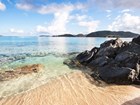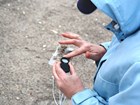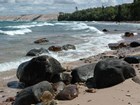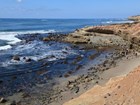Ocean basins serve as collecting bins for eroded debris that is washed from continents. Studying the sediment source(s), color, size, and sorting on the beach helps the coastal geologist to understand and describe the dynamic systems that transport, deposit, and erode our coasts and shorelines.
-
Article 1: Coastal Sediments—Parent Material

Beach sediments may come from many locations and sources. The parent material may be located nearby or far away and transported long distances by rivers and ocean currents. Parent material and the coastal processes that move sediments to the beach determine the appearance and physical characteristics of a park's shorelines and beaches. Read more
-
Article 2: Coastal Sediments—Sand Colors

The color of beach sands and other sedimentary debris can give a beach a distinctive hue. Sand color tells a story of parent material, weathering, and transportation along the coast. Read more
-
Article 3: Coastal Sediments—Material Size

Beach and coastal sediments can range in size from microscopic clay particles to large boulders. Mud, sand, and gravel are the most common material sizes, and can originate from a wide variety of rocks and minerals. Read more
-
Article 4: Coastal Sediments—Sorting

Rivers and high-energy coastal environments transport and shape sediments that are deposited on beaches. The distribution of and sorting of sediments on the beach can help us understand a beach's inherent dynamics. Read more
